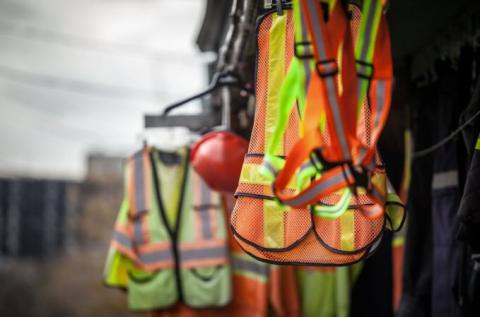Online Technical Training Blog

Key Safety Practices Every Technician Should Know
Anyone working in skilled trades must prioritize safety in everything they do. It’s simply non-negotiable. However, those working in construction, electronics, HVAC, or solar installation don’t automatically have those skills. Safety practices must be taught and learned.
If you’re working in the field or just getting started in a trade, knowing and perfecting your skills in these key safety practices can make the difference. Demonstrating these skills shows your ability not only to follow the rules but also to prioritize your safety and that of every other member on your team.
The Use of Personal Protective Equipment
Wearing Personal Protective Equipment (PPE) may not always be comfortable, but it’s essential for protecting yourself in high-risk situations. The PPE you need is dependent on the specific tasks at hand. However, technicians typically need to know how to use and maintain the following PPE:
- Hard hats for head protection
- Steel-toed boots for foot protection
- Gloves that are suitable for chemicals or insulated from electrical risks
- Safety glasses or goggles
Your employer must provide you with the necessary tools to ensure your safety. However, you have to use them.
Electrical Safety Practices
The electrical industry is one of the most challenging to work in from a safety standpoint. The risks you take are manageable, but only if you follow them critically and carefully. This includes:
- Guarantees of isolation: A formal process must be followed to ensure that all equipment is de-energized and cannot be re-energized during work.
- Lockout/tagout: The implementation and consistent use of LOTO prevents accidental re-energization.
- Grounding and bonding: Proper grounding and bonding of electrical systems are critical to prevent shock hazards.
Note that Electronics Technicians must understand the specific types of equipment they are using. Only qualified professionals with the necessary certificates can and should operate on such equipment.
Construction Industry Standards
Construction trades are also highly dangerous due to the constantly changing environment and numerous risks. The Canadian Construction Safety Council has numerous rules in place that every tradesperson working in the industry must adhere to as a way to minimize risks. Among the most critical of those best practices include:
- Specific task training, especially in areas where hazardous energy control is necessary, teams work at heights, or there is a need to navigate confined space entry, is crucial.
- Hazardous material identification is another critical skill. Safety practices must focus on identifying and properly communicating risks, including biological, chemical, or physical hazards.
- Worksite safety measures will change from one location to the next. Hazard assessment of the worksite before work begins, fall protection implementation and management, and general housekeeping are also safety standards professionals must adhere to during their daily job tasks.
In construction sites, where risks are constantly present, tradespeople must be ready to act even when the unexpected occurs. Having these skills enables that.
Emergency Response and Preparedness
A critical aspect of safety in the trades is the ability to respond effectively to emergencies and hazardous conditions. Even with the most careful planning, unexpected situations can arise and create serious risks. As a trades professional, you should have skills in the following areas:
- Understanding the specific location’s risks, whether environmental, chemical, respiratory, or others. This includes inspecting for hazards every day prior to the job start.
- Creating, practicing, and being ready to use emergency procedures in high-risk environments. This includes completing regular drills to ensure that you are fully prepared to react in the event of a tragic outcome.
- Providing immediate care in the event of an emergency is also necessary. This skill comes from understanding more than basic first aid, but should also include strategies for providing more advanced care in high-threat environments.
Finally, knowing when not to engage is a safety practice in itself. Under Canadian law, you have the right to refuse unsafe work. Recognizing and acting on that right - and reporting unsafe conditions to the appropriate parties - helps reduce risk for both you and your team.
Equipment Inspection
Safety practices surround not just the tasks you perform but also the tools you use. A skilled trades professional knows how to use the tools of their trade properly and safely and takes adhering to strict usage requirements seriously.
In addition, you should know how to inspect equipment to look for potential flaws, including portable equipment and equipment that is permanently affixed. This includes understanding how to avoid overloading circuits in electrical work, as well as pinpointing damage to tools that create common risks. Equipment requirements must be followed, and any concerns should be reported as they arise.
Learning and Mastering Trade Safety Practices
A core component of safety in the trades is understanding risk and knowing how to respond. While much of this is learned on the job, a critical error on site is too late to start learning. That’s why every technician benefits from structured safety training that builds awareness and confidence before stepping onto a job site
The Construction Health & Safety Micro-Credential from George Brown College specifically focuses on these and related safety practices. Explore how GBC construction health and safety education fits into the work you do. These skills can prove to be critically important in mastering them if you plan to work in the field successfully without putting yourself or others at risk. Formal training in a program like this, along with on-the-job training, assures long-term safety of individuals and teams.
If you still have questions, call our expert Program Consultants toll free at 1-888-553-5333 or email us at [email protected]


